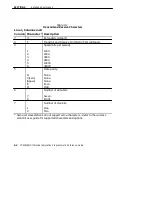
SECTION 8
"
Programming
VT220/ANSI Terminal Emulation Programmer’s Reference Guide 8-69
Scanning in Local Edit Mode
When scanning is enabled, data from the scanner is placed
into the field where the cursor is located. If the cursor is
not in an input field, the data from the scanner is placed
into the next input field. If the data from the scanner fills
the first input field, the remaining characters are placed
into the next input field.
When the bar code does not fill the input field, the cursor
stays where it ended. If autotab scanning is enabled, the
cursor is placed at the beginning of the next input field. If
not next input field is found, extra data will be lost.
Set Transmit Termination Character
(DECTTC)
The wireless station supports the set transmit termination
character (DECTTC) control function. Use the control func-
tion to select a character to indicate the end of a block
transmission. You do not need to use an end-of-block char-
acter. The wireless station sends the end-of-block character
to the host at the end of each block transmission.
The control sequence is:
CSI Ps
ê
Ps is the end-of-block character in the following chart.
Ps
End-of-Block Character
Wireless Station
Action
0 (default) No character (DECTTC
disabled)
1
FF (0C hexadecimal)
Form feed
2
ETX (03 hexadecimal)
End of text
3
EOT (04 hexadecimal)
End of transmission
4
CR (0D hexadecimal)
Carriage return
5
DC3 (13 hexadecimal)
XOFF
Summary of Contents for VT220/ANSI
Page 4: ......
Page 18: ...CONTENTS xiv VT220 ANSI Terminal Emulation Programmer s Reference Guide...
Page 26: ...SECTION 1 Introduction 1 8 VT220 ANSI Terminal Emulation Programmer s Reference Guide...
Page 264: ...APPENDIX A Bar Code Scanning A 4 VT220 ANSI Terminal Emulation Programmer s Reference Guide...
Page 276: ...INDEX Index 12 VT220 ANSI Terminal Emulation Programmer s Reference Guide...
















































